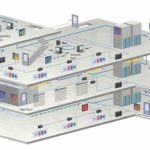The Rise of Sustainable Building Practices in the Construction Industry
As concerns about climate change and environmental sustainability continue to grow, the construction industry is undergoing a significant shift towards more sustainable building practices. In this article, we’ll explore the reasons behind this shift and the ways in which sustainable building practices are transforming the construction industry.
The Benefits of Sustainable Building Practices
- Reduced energy consumption: Sustainable buildings are designed to be energy-efficient, which means they use less energy than traditional buildings. This can lead to significant cost savings on energy bills.
- Improved indoor air quality: Sustainable building materials and design practices can help improve indoor air quality, which can have a positive impact on the health and well-being of building occupants.
- Reduced environmental impact: Sustainable building practices minimize waste and reduce the carbon footprint of buildings, making them better for the environment.
- Increased property value: Sustainable buildings are becoming increasingly popular among buyers and renters, which means they can command higher prices and rents.
Energy-Efficient Building Design
Energy-efficient building design is a crucial component of sustainable building practices. Here are some examples of energy-efficient building design principles and how they are being used in the construction industry:
- Passive solar design: Passive solar design uses the sun’s energy to heat and cool buildings, reducing the need for mechanical heating and cooling systems.
- Building orientation: The orientation of a building can have a significant impact on its energy efficiency. Buildings that are oriented to take advantage of natural light and breezes can reduce the need for artificial lighting and cooling systems.
- Efficient HVAC systems: HVAC systems are a major source of energy consumption in buildings. Energy-efficient HVAC systems, such as those that use geothermal or solar power, can significantly reduce energy consumption.
Sustainable Building Materials
Sustainable building materials are a crucial component of sustainable building practices. Here are some examples of sustainable building materials and how they are being used in the construction industry:
- Bamboo: Bamboo is a fast-growing, renewable resource that can be used for flooring, cabinetry, and other building materials. It is durable, strong, and has a unique aesthetic that is becoming increasingly popular in modern design.
- Recycled materials: Recycled materials, such as reclaimed wood and recycled glass, are being used more frequently in construction projects. Not only do they reduce waste and minimize the need for new resources, but they can also add a unique and interesting element to a building’s design.
- Insulation: Proper insulation is essential for energy-efficient buildings. Sustainable insulation options, such as cellulose insulation made from recycled newspaper or denim, can provide effective insulation while also being environmentally friendly.
- Green roofs: Green roofs are becoming increasingly popular in urban areas. They involve planting vegetation on the roof of a building, which can help reduce the heat island effect and improve air quality.

Sustainable building practices are transforming the construction industry, as builders seek to reduce their environmental impact and meet growing demand for eco-friendly buildings. By incorporating energy-efficient building design, sustainable building materials, and other sustainable practices, builders can create buildings that are better for the environment, healthier for occupants, and more cost-effective to operate.




